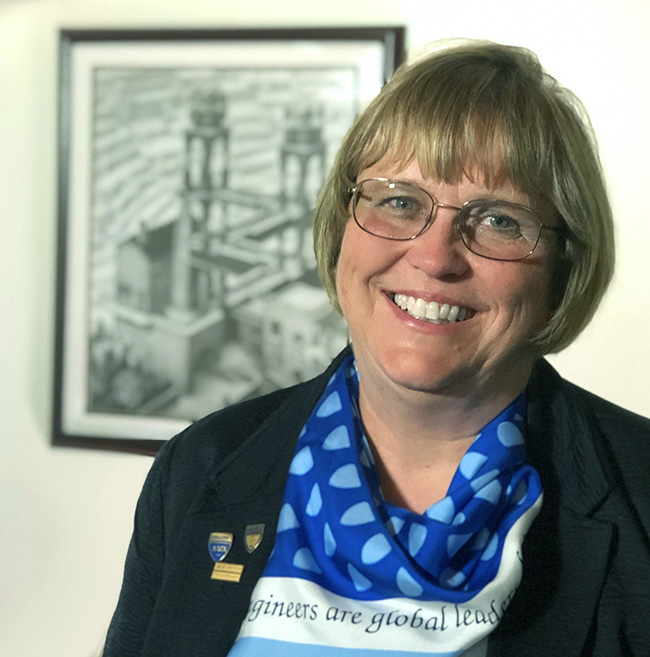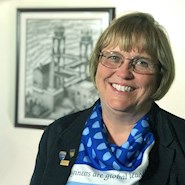By Maria C. Lehman, P.E., ENV SP, F.ASCE

Happy New Year! New beginnings are springing up, and disruption is the theme.
When ASCE Executive Director Tom Smith, CAE, ENV SP, F.ASCE, called me on a Friday in June 2021 to tell me I won the Society’s presidential election, he said that my year as president-elect would fly by. So I told him to take the weekend off and we’d hit the ground running on Monday. And that’s what happened. We’re working hard to solve our profession’s most pressing challenges. And elected officials, industry leaders across all sectors, and the media are noticing!
When the Infrastructure Investment and Jobs Act — also called the bipartisan infrastructure law — was passed, there was champagne on Thursday, Friday, and Saturday. But Sunday brought the hangover: the realization that we needed to deliver! After more than two decades of advocating for increased federal investment, we got it.
So we had to pivot. We needed to focus on implementation and working with the federal government to streamline the entire process. We went to work advocating for changes in delivery, which led to my appointment to serve on President Joe Biden’s National Infrastructure Advisory Council.
A year later, we’ve delivered several programs: IIJA Recommendations for Effective Implementation; creating the IIJA Implementation Resource Center and monthly webinars; connecting the IIJA, civil engineering, and JEDI (justice, equity, diversity, and inclusion); participating in the White House Accelerating Infrastructure Summit; and much more. And we’re just getting started!
But the act’s passage also required us to assess ASCE. So much has changed since the implementation of the last strategic plan in 2018: remote work, supply chain disruption, social and economic justice movements, sustainability and resilience, the great resignation, and the workforce crisis. We needed to reboot ASCE’s priorities.
In October, the Board of Direction unanimously passed a new strategic plan in a record seven months, bolstered by the most extensive outreach ever for such a plan. Under the leadership of the Board Strategic Advisory Implementation Subcommittee and Chair Feniosky Peña Mora, Sc.D, P.E., F.ASCE, a plan emerged that is simple yet powerful.
Six strategic shifts accompanied by key measurable strategic objectives were outlined in two main sections of the plan. These calls to action highlight specific stakeholders under each. “Innovate” and “Advocate” apply to societal shifts and objectives; “Inspire” and “Stimulate” apply to the profession; “Magnify” and “Deliver” apply to ASCE membership. These shifts are drivers of change, generating new objectives for the organization.
The plan emphasizes member value and a diverse, engaged civil engineering community. It also focuses on sustainable, resilient, future-ready infrastructure while putting ASCE members and the civil engineering profession at the forefront of that work.
Our next step is to implement the plan. The BSAC subcommittee, while developing the strategic plan, also laid out a series of metrics. Each objective has action key performance indicators and impact key performance indicators.
But what does this mean to our members? What can you do?
You are the boots on the ground! Your involvement is critical in helping our organization and profession succeed. Addressing the current workforce crisis was a top priority for our new strategic plan. It’s also an area where you can have the most impact by mentoring and inspiring younger generations of civil engineers.
We must enhance the pipeline of people studying engineering and allied professions, including technicians and technologists. We need to change the workplace to create a better culture of work-life balance, to focus on JEDI, to increase salaries so we retain current talent, and to mentor junior and midlevel engineers to advance into positions of authority and leadership.
Throughout my career, I’ve been fortunate enough to have supervisors and mentors who pushed me to do things I hadn’t done previously. I learned how to be comfortable with being uncomfortable. I can tell you that I would not have advanced the way I did without my ASCE involvement. At a young age, I was exposed to senior leaders in our profession who were pushing the envelope. Most of my safe-place learning occurred within my ASCE family.
So I encourage you to grow your network, use ASCE Mentor Match, and bring your expertise to make the world a better place. The future of civil engineering is what we make it. So shoot for the moon. Even if you miss, you’ll land among the stars.
This article first appeared in the January/February 2023 issue of Civil Engineering as “Civil Engineering and ASCE Are Storming the Future.”



